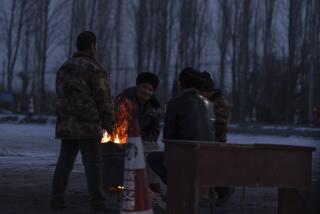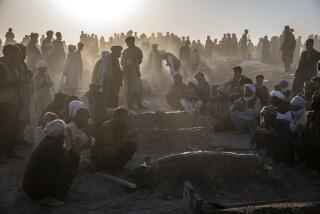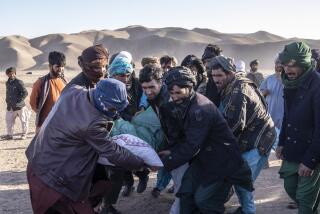7.0 Quake Hits Soviet Georgia, Kills at Least 30
MOSCOW — A powerful earthquake struck the southern Soviet republic of Georgia at noon Monday, burying mountain villages with rockslides and tearing apart homes, schools and shops. About 30 people were killed, according to preliminary government figures.
The quake had a magnitude of at least 7.0, scientists reported. Another tremor, nearly as strong as the first, came a little more than nine hours later as soldiers and rescue workers searched through the night for victims still trapped in the rubble.
The initial earthquake was centered near the village of Dzhava, a town of about 11,000 in the politically troubled region of Southern Ossetia. The Soviet Geophysics Institute assigned it a magnitude of 7.0. Seismologists in Sweden and the United States put it even higher, at 7.2, noting that such a quake is capable of causing widespread, heavy damage with resulting loss of life in populated areas.
The shock waves continued through the afternoon and were strongly felt in neighboring Armenia, where a 1988 earthquake killed more than 25,000 people, and across the Soviet border in Turkey and Iran.
Altogether, the earthquake was felt strongly over a 300-mile path from Grozny in the Russian Federation in the north to Yerevan, the capital of Soviet Armenia, in the south.
Although more powerful than the Armenian earthquake, which measured 6.9, the Georgian tremors apparently did less damage, according to late reports, because of differences in local geological conditions.
The official news agency Tass, quoting Georgian officials, said that according to preliminary reports, about 30 people had been killed, but it gave no details nor an estimate of the number of injured.
A police spokesman in the regional center of Kutaisi, however, later told the Associated Press that at least 40 people had been killed.
Hospitals in Tbilisi, the Georgian capital, were alerted to receive hundreds of injured from the area, local doctors said, but by late Monday only six people, four women and two men, all gravely injured, had been brought to the central hospital there.
Ten people were reported killed in Dzhava, which lies about 60 miles northwest of Tbilisi.
Squads of soldiers were shown on the nightly television news program “Vremya” working along with local residents to dig out, sometimes with nothing but their hands, more than 30 homes buried beneath the rockslides there and to clear the rubble of collapsed buildings in the search for survivors.
“Dzhava is waiting for help,” a television correspondent reported as the rescue efforts continued.
The troops had been guarding a convoy of supplies for Dzhava and an adjacent village because of the continued fighting between the Ossetians and the Georgians, and they had entered the village just at the moment of the quake. After picking themselves up from the dust, they set about rescuing those trapped.
“The bodies of nine people have been dug out in Dzhava,” the independent news agency Interfax said in a progress report, later updating the figure to 10. “This work has just begun, and so it is feared that the number of deaths may be considerable.
“In Dzhava, a kindergarten, a secondary school, a hospital, a printing shop, administrative buildings and more than 30 dwellings have been buried.”
The damage, in fact, was widespread. Ambrolauri, a town of 17,000 near the first earthquake’s epicenter, and Oni, about 20 miles away, both reported six people dead. In Zestafoni, on the road from Tbilisi to Kutaisi, eight people were killed, according to initial reports.
“More than half of the city’s buildings have been destroyed or damaged,” a town official in Zestafoni said. In Sachkhere, the railroad station was virtually destroyed, and in nearby Chiatura a rockslide swept through a residential area of the town, crushing some houses, burying others.
Rescue teams were arriving in Tbilisi by nightfall Monday--first from Armenia, where heavy losses from the 1988 earthquake gave them special motivation, from elsewhere in the Soviet Union and from abroad, including the International Red Cross in Geneva and the American Red Cross in Washington.
“The lesson of Armenia ’88 is--fast, fast, fast,” an official at the Georgian Parliament said. “Get in fast and work fast. . . .”
More to Read
Sign up for Essential California
The most important California stories and recommendations in your inbox every morning.
You may occasionally receive promotional content from the Los Angeles Times.










